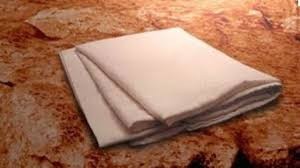 Unless this is your first day on the internet, you’ve probably received the email describing why Jesus folded the napkin in the tomb at His resurrection at least a dozen times. It has been circulating for years now. I think I get it about once each week.
Unless this is your first day on the internet, you’ve probably received the email describing why Jesus folded the napkin in the tomb at His resurrection at least a dozen times. It has been circulating for years now. I think I get it about once each week.
The email purports that there was an early tradition concerning a master, his servant, and the dinner table. Reportedly, if the master of the house is completely finished with his meal, he doesn’t fold the napkin, but wads it up. This supposedly tells his servant that he is finished, and will not be returning. However, if he is leaving the table before he is finished with his meal, he folds the napkin as a sign to his servant that he coming back. The email states that when Jesus’ folded napkin was found in his empty tomb that this was a sign to His disciples that he would one day return.
I’ve been reading the Bible – and Bible related stuff – since I was a young teenager. I can honestly say that before I read this email I had never heard of the tradition it describes. Now, I am certainly not saying that I am some unique repository of Biblical knowledge; however, I do find it a little strange that something so significant had been missed for so long.
To be perfectly honest, this email has the “feel” of urban legend. But, rather than discuss my “feelings” on the subject, let me share some reasoning that might lend some insight.
I have two issues with this email. The first is the word “napkin.”
When Peter and John look in the tomb, they find the “napkin” folded up. Only the King James Version uses the word “napkin.” All other translations use “face-cloth” or “burial-cloth” or something like that.
Today, we use the word napkin to describe a piece of cloth (or paper) that we use at the table to wipe our hands and mouth as we eat. The Greek word used in John 20:7, which is translated “napkin” in the KJV (according to Strong’s), is a towel or cloth used to wipe facial sweat, or to be used as a burial cloth. There is no evidence that it was also used as a table napkin.
This would make one wonder why Jesus would fold a burial towel with the hopes that His disciples would reach the conclusion that it is like folding a table napkin. There is nothing in common between a burial scene and the dinner table. And, there would be no logical reason for associating these two different items with each other. Oh, look, there’s a folded burial cloth. That reminds me of eating lunch!
I think the circulated-email exploits the KJV’s use of the word napkin. The email wants us to believe that in Jesus’ time, people used burial cloths to also wipe their mouths. I highly doubt that is the case. Mommy, I just spilled soup on my chin; will you pass me the burial cloth?
The second problem that I have with the story is that for centuries the Church has understood a simpler and more obvious reason for the folded grave cloth: the empty tomb was not the scene of a grave robbery. No grave robber would have taken the time to fold the burial cloth while stealing the body of Jesus. This is especially true when one realizes that the grave was being guarded by soldiers, and a thief would not have taken the time to be so tidy in his thievery.
So, was the burial cloth folded because Jesus was conveying a sign that He would one day return? I really doubt it. The disciples didn’t even know Jesus was going to rise from the dead – let alone return (Mark 16:11)!
In my opinion, Jesus folded the burial cloth because He was unhurried, unthreatened, and an overall orderly Person. I think that He wanted anyone who would have looked in on the tomb to know immediately that it was not a chaotic crime scene, but that of a resurrection.
I highly suspect that someone just has an overactive imagination.
Oh well …
Peace,
dane